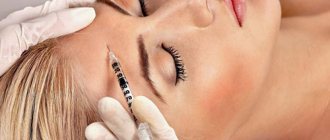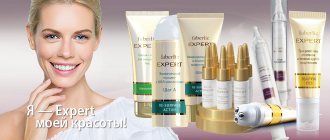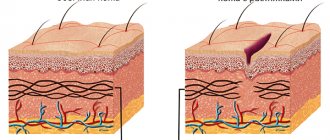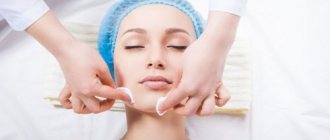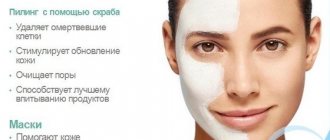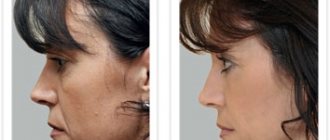Principle and types of cleansing
Peeling is an important and responsible cosmetic procedure. Its main purpose is to remove (exfoliate) dead cells and keratinization from the thickness of the skin.
As a result of cleansing, a number of other positive changes occur in the skin:
- metabolic processes in epidermal cells are accelerated;
- the functioning of the sebaceous glands is normalized, excess oiliness and dryness of the integument disappears;
- the relief of the surface of the face is smoothed, scars, scars and post-acne are corrected;
- skin color is evened out, age spots and freckles are lightened;
- the elasticity of the fibers increases, a lifting effect is observed;
- the skin becomes healthier, the incidence of acne and the development of acne are reduced.
The peeling procedure allows not only to correct visible skin imperfections, but also to prevent their development in the future. This is especially important for the prevention of early aging, the formation and deepening of wrinkles, and sagging soft tissues.
Removal of dead cells during peeling is accompanied by injury to the integument to a greater or lesser extent. Various techniques can be used to eliminate skin problems:
- Exfoliation or chemical peeling of the face - the procedure involves the application of an acidic, chemical composition. As a result of exfoliation, an extensive chemical burn occurs. The restoration of the integrity of the integument during chemical peeling is highly pronounced: active peeling occurs, the surface layers are torn away, giving way to renewed fibers.
- Hardware peelings - problem areas are affected by ultrasound, laser, microcurrents, radio frequencies and other factors. This type of cleansing involves special equipment, equipment, hence the name of the technique. The skin is less traumatized during hardware cleansing, and therefore the consequences of peeling are less pronounced.
- Mechanical cleaning is the simplest, but no less traumatic type of cleansing. The upper layers of the epidermis with skin problems seem to be “ripped off.” If superficial cleansing has virtually no significant side effects, then after deeper procedures (such as dermabrasion, microdermabrasion) proper, special care will be required.
- There is another type of peeling - enzymatic. It provides delicate superficial cleansing. Enzymes are used to solve minor skin problems. They do not violate the integrity of the integument, act gently and do not require special care.
When choosing a skin cleansing method, carefully study the preparation requirements for its implementation, indications and contraindications, further skin care after facial peeling, consequences and possible complications.
A detailed study of the peeling procedure and compliance with all specialist recommendations guarantees a positive result without unpleasant consequences or complications.
Cleansing with acids and chemical compounds has pronounced post-peeling consequences. That is why we will consider to a greater extent the consequences of chemical peeling of the face.
After a chemical peel, you get a burn on your face. The body activates the renewal of the integument to replace damaged fibers with new ones. Chemical peeling does not end in the beauty salon; post-peel skin care plays a significant role in the speed of recovery.
Cosmetologists divide all the consequences of peeling into 2 groups: expected and unexpected.
The expected consequences are a normal, acceptable reaction of the skin to the impact performed. Such phenomena include moderate erythema, mild swelling in sensitive areas, active peeling and others. To eliminate side effects, no special treatment is required, only proper care, the use of moisturizing, natural cosmetics and wound-healing ointments.
Unexpected (unpredictable) consequences or complications after peeling are an unusual reaction of the body to the cleansing performed. The patient's skin condition worsens, the rehabilitation period is delayed in time, and special treatment is required. Such consequences include persistent, prolonged erythema, severe swelling, the appearance of rashes and irritations on the face; suppuration of damaged areas, marbling of the skin and others.
Only a specialist can determine how to act if unpredictable consequences develop. Self-treatment is dangerous due to the deterioration of the situation and residual scars on the face.
It is worth noting that the predicted consequences are typical for each patient and cannot be avoided. But not everyone develops complications, and in most cases it is possible to prevent their development.
Side effects after exfoliation
We wrote above that there are predictable side effects that always occur in cases of invasive intervention in the body. These are temporary phenomena. They should not cause concern, as they do not harm the body and disappear within a couple of days after the procedure. Usually this:
Peeling is the basis of the peeling mechanism as such. It is a common consequence and goes away within 1-3 days. However, after using trichloroacetic acid or resorcinol, large scaly peeling may occur and persist for a week or longer.
- moderate hyperemia;
- erythema (severe redness of the skin);
- peeling of the skin;
- swelling;
- crust formation.
Skin hyperemia is a normal skin reaction to chemical agents. It occurs due to damage to the skin, and its intensity depends on the degree of aggressiveness of the chemical.
In cases where the patient violates post-peeling measures, prolonged and persistent skin erythema is possible.
Peeling of the skin after the procedure also depends on the degree of aggressiveness of the chemical, the technology used and timely rehabilitation.
For example, after superficial peeling, peeling is almost unnoticeable, after medium peeling, peeling is observed with the formation of thin brown crusts, and after strong peeling, peeling is widespread and pronounced with the formation of deep crusts. In different areas of the skin, peeling has different intensity, which is associated with the thickness of the epidermis and the number of sebaceous glands.
Hyperpigmentation occurs when there is an inadequate cellular response and excessive melanin production by cells, resulting in dark areas. This most often occurs after treatment with trichloroacetic acid or exposure to a laser beam.
Edema is a peculiar reaction of the skin to external irritants. After peeling, the permeability of the capillaries increases, fluid leaves them and accumulates in the tissues, thereby causing swelling.
Reasons for the development of complications
Complications after peeling are mistakes that the cosmetologist made during cleansing or the patient made in facial care before and after peeling. Among the reasons for the development of unpredictable consequences of peeling, cosmetologists identify the following:
- Neglect of contraindications. Even a minor scratch on the face or abrasion can provoke a complication. One of the most common such reasons is peeling during menstruation, while taking hormonal contraceptives or during breastfeeding. Changes in hormonal levels can significantly affect the outcome of the procedure, so during such periods it is better to avoid peeling.
- Low experience and skill of a cosmetologist. Violation of speed, order of application of the exfoliant, the acid composition was applied unevenly or was left on the face longer than necessary - all this affects the result and threatens with serious consequences, deep burns.
- Failure to comply with pre-peeling preparation requirements. Before performing medium and deep cleansing, the patient must prepare the skin for further exposure. Before chemical peelings, cosmetologists recommend using special cosmetics containing a minimum amount of these acids; before hardware cleanings, you can do a superficial acid peeling. It is also important to take antiviral medications before any serious peeling. Herpes rashes during the rehabilitation period are also considered post-peeling complications.
- Improper skin care after peeling. After the cleansing procedure, the skin fibers are very weakened, so the slightest mistake can cause serious trouble. For example, the cosmetics you used before the procedure can now irritate the skin and cause an allergic reaction, so cosmetologists recommend their own line of cosmetics (they usually cost more). It is very important to adhere to the rules of care and avoid increased sweating, because with sweat, dirt and infection can get into the wound formed on the face.
- Individual characteristics of the patient's body. It is very difficult to predict a negative reaction of the body. The minimum you can do is to conduct an allergy test and take into account previous experience of this type of procedure.
Maximum responsibility on the part of the performer and the patient are the main factors that will help reduce the risk of complications. Approach the choice of staff and beauty salon more seriously, but also be aware of your actions if you want to achieve positive changes on your face.
Indications and contraindications
Indications for chemical peeling:
- problematic skin with comedones, acne, post-acne;
- scars, ingrown hairs;
- oily skin with enlarged pores;
- thickening of the stratum corneum, uneven relief;
- dull skin color;
- dark spots;
- sagging, lack of elasticity and tone of the skin;
- photoaging due to intense UV radiation;
- folds, wrinkles, sagging, other age-related changes.
Indications by age:
- adolescence from 14 years old - as prescribed by a doctor;
- 25-30 years – acne, post-acne, age spots, photoaging, prevention of skin aging;
- 35 years and older – prevention and elimination of cosmetic defects, preparation for other cosmetic procedures.
Contraindications to the procedure can be absolute - irremovable, and relative - removable.
Absolute contraindications to chemical peeling:
- predisposition to the formation of keloid and hypertrophic scars;
- poor wound healing;
- skin hypersensitivity;
- mental disorders;
- individual intolerance to the components of the peeling composition;
- pronounced rosacea;
- oncological diseases;
- IV-VI phototypes according to Fitzpatrick;
Relative contraindications to the procedure:
- nevi;
- hypertrichosis;
- menstruation;
- exacerbation of chronic diseases;
- acute infectious and inflammatory diseases;
- pregnancy and breastfeeding;
- fresh tan;
- less than 8 weeks from the date of traumatic cosmetic procedures - deep cleaning, laser resurfacing, mesotherapy;
- taking photosensitizing drugs, retinoids, immunosuppressants;
- exacerbation of psoriasis, atopic dermatitis, allergic dermatosis, eczema;
- viral, fungal, bacterial, as well as mechanical skin lesions in the affected area;
- decompensated diabetes mellitus and hypertension.
Stages of the procedure
- Pre-peeling preparation. They are carried out in order to adapt the skin to the active and even out its surface layer for better penetration of the peeling composition. Carry out 1-2 weeks before the procedure or immediately before the session.
- Actually peeling. It is carried out according to the protocol, depending on the composition chosen by the cosmetologist.
- Post-peeling care. Helps to consolidate the results of the procedure and avoid complications. Appointed by a cosmetologist.
Acceptable consequences of peeling
After deep cleansing with laser, dermabrasion and chemical peeling, the following consequences are expected:
- Erythema or severe facial redness in the treatment area. The more aggressive the impact, the stronger the redness will be. If post-peeling care is not disturbed, the side effect goes away on its own. If the patient does not follow the care specialist’s instructions, visits baths, or drinks alcohol, then the erythema may intensify and last for a long time.
- Pronounced peeling. Thus, the skin rejects damaged fibers and is renewed. It is impossible to tear off or rip off loose films - this is dangerous due to scars and the appearance of wounds. In some cases, cosmetologists recommend that large sagging areas be carefully trimmed without touching the skin. To speed up renewal and the passage of peeling, cosmetologists insist on using wound-healing ointments.
- Mild swelling in sensitive areas (near the eyes, mouth). Increased permeability of small vessels in these areas provokes fluid accumulation. Swelling persists for up to 3 days and goes away on its own.
- Tightness of the integument. The characteristic discomfort can be reduced by regular application of moisturizing cosmetics and tonics. Cosmetics must be non-allergenic and approved by a cosmetologist.
- Darkening of the skin (even). Goes away on its own in 7–10 days.
- Increased susceptibility (sensitivity) of the integument. This deficiency can last from 1 week to 1 year. It is expressed in a sensitive, sometimes painful reaction to sunlight, temperature changes, touch and mechanical stress.
The predicted effects of peeling are temporary and do not require additional therapy, only observation and skin care prescribed by the cleansing technique.
Retinoic peeling and retinoic dermatitis
- home
- Publications
- Blog
- Retinoic peeling and retinoic dermatitis
Case from practice
A 28-year-old patient came to me with complaints of rashes on the skin of the face, legs and hands in the form of papules and pustules against a background of erythema, accompanied by itching and hyperesthesia. The rash first appeared 5 days after a retinoic peeling containing 5% retinoic acid was performed by a cosmetologist.
The cosmetologist who performed the procedure recommended using hormonal ointment 2 times a day for 5–10 days. The rash disappeared but reappeared as soon as the patient stopped using the drug.
During the medical history, it turned out that a month before the retinoic peeling, the patient underwent a median glycolic peeling procedure.
Retinoic dermatitis
The cosmetic procedures carried out thinned the epidermis, and the regenerative capabilities of the patient’s skin weakened. As a result, retinoic dermatitis, which can develop after retinoic peeling, was more pronounced in this situation.
It should be noted that the use of topical and systemic glucocorticosteroids is appropriate only for retinoic dermatitis, which occurs with disturbances in the general condition of the body: increased body temperature, erythroderma. In other cases, their prescription, and then cancellation, can lead to the development of even more pronounced retinoic dermatitis.
Therapy
As a result of the examination, the patient was prescribed therapy aimed at relieving the symptoms of retinoic dermatitis.
- Take an antihistamine once a day, at night, for 10 days to relieve itching.
- Take enterosorbents – 1 dessert spoon once a day between breakfast and lunch for 10 days.
- Apply a thin layer of zinc paste to areas of skin with manifestations of retinoic dermatitis once a day, at night, for 5 days.
- Apply the softening emulsion to areas of skin with manifestations of retinoic dermatitis 2 times a day for 2 weeks.
In 2 weeks
Two weeks later the patient came for examination. Manifestations of retinoic dermatitis have regressed. The itching has stopped. The patient was satisfied with the result of the treatment.
I recommended that she use sunscreen for 1 month and not exfoliate before 3 months. In addition, the patient was strongly advised not to use hormonal ointments without consulting a dermatologist.
Retinoic peeling often leads to manifestations of retinoic dermatitis. Therefore, when performing such a procedure, it is necessary to warn the patient about a possible adverse reaction and give recommendations for skin care.
If the patient needs several retinoic peeling procedures, but after the first procedure severe retinoic dermatitis appears, then subsequent peeling procedures can be replaced by daily application of the Retasol ® solution for 7–10 days, with breaks between courses of 1 month, but not more than 3 courses in a row and only in winter.
Patients will thank you!
Anna Vyacheslavovna Karpova, Employee of the Scientific Dermatological Candidate. honey. Sciences, assistant at the Department of Dermatovenereology and Cosmetology, Federal Scientific and Medical Education, RUDN University
or leave a comment
Oleg
| 04/13/2018 16:48 Why enterosorbents in this case?
Hello, Oleg! The task of enterosorbents is to bind and remove immune complexes from the body and general adsorption.
What shouldn't happen?
Worry and immediate action can cause unpredictable post-peeling consequences. They may appear not only in the first days after peeling, but also later. These include:
- An allergic reaction, expressed by swelling, itching, and rashes all over the body. The most dangerous expression of allergy is considered to be Quincke's edema. If help is not provided in a timely manner, the consequences can be very tragic. Mild stages of allergies can be eliminated with antihistamines, but in case of breathing problems and complex allergy symptoms, hospitalization and emergency treatment will be required.
- Persistent erythema. This complication is typical for deep peeling; patients with rosacea on the face are at risk. The unpleasant phenomenon can last up to 1 year. To reduce the period of complications, it is recommended to adhere to certain rules, avoid increased physical activity, baths and saunas, alcoholic beverages and spicy, hot dishes.
- Herpes. It is better to avoid this consequence. For this, the cosmetologist prescribes antiviral drugs. If herpes does appear, immediately turn to medicinal ointments (for example, Acyclovir).
- Marbling of the skin. Occurs after deep peeling. The reason for this unpleasant consequence is the destruction of a large number of melanocytes. It is impossible to get rid of the marble shade, only partially correct it.
- A clear dividing (demarcation) line. Characteristic for owners of dark-skinned skin. A course of superficial peelings will help blur the clear boundary.
- Acne on the face. To treat this effect, vitamin complexes and antibiotics are used.
- Hypertrophic, keloid scars. The complication is caused by the individual characteristics of the patient’s skin and body. To eliminate residual scars, it is recommended to use surgery, laser resurfacing and other complex procedures.
Unpredictable consequences are a reaction to mistakes made by the cosmetologist and the patient in cleansing. To correct them and completely eliminate them, contact a specialist. He will prescribe drug therapy and a course of other peelings. Be patient, it may take a long time to remove post-peeling complications.
GENERAL PROHIBITIONS FOR EXFOLIATION: CHECK LIST
Universal advice that is usually given to those planning peeling: at least contact a cosmetologist-dermatologist for an initial consultation and exclude contraindications. Even a cursory professional assessment of the general situation will significantly save both time and money invested in a course of even home procedures.
At the same time, it is important to carefully select a clinic and a specific specialist based on reviews from real patients. After all, a non-professional may not take into account any contraindications for peeling, which will almost certainly lead to disastrous complications.
For example, doctors at the Herpes Clinic still talk about one of their patients on the sidelines. After peeling, she was forced to treat the consequences in the form of cheek dermatitis (rash and itching) for 8 months. The relapse of the disease occurred due to the girl’s predisposition to herpes infection: this factor was obviously not taken into account by the unqualified cosmetologist.
So, which groups of people should avoid peeling and why? Let's look at them in more detail.
Pregnant women
Concerns regarding peelings during pregnancy are associated with a number of factors:
- Firstly, the expectant mother is afraid of harming the baby.
- Secondly, it is very difficult to predict how the woman’s body will react.
Due to the restructuring of the endocrine system, even familiar and proven cosmetics can provoke redness and itching. What can we say about more toxic (for example, acidic) drugs.
At any stage of pregnancy (especially in the second and third trimesters), it is more important than ever to take precautions. Ideally, check in person:
- Compliance of drugs with expiration dates,
- Sterility of peeling instruments,
- Availability of certificates and licenses for a cosmetologist.
Nursing mothers
The ban on medium and deep peels for women during lactation is clear. This is explained by the fact that harmful substances during such procedures can enter the common bloodstream of the mother and child.
However, even to superficial exfoliation, the body, exhausted by childbirth, can react with a rash, age spots or fungal infection. Among other things, this is explained by increased hormonal loads: the baby is still just forming its own immune system and borrowing strength from the mother.
We recommend: MECHANICAL PEELING: polishing beauty
Although doctors have different opinions about the admissibility of certain peels during breastfeeding, as a rule, exfoliation is prohibited during this period. The main reason is the same poorly predictable result.
Those suffering from herpes
Many people are surprised that herpetic infection is localized, in addition to the lips, throughout the body. The HSV-1 virus also appears in the form of “bubbles”-vesicles on the wings of the nose, ankles, eyes and mucous membranes.
After the first attack on the body, herpes remains “dormant” in the human immune system. Getting rid of it forever is considered very difficult: with every hypothermia, as well as an acute respiratory viral infection or influenza, the infection makes itself felt again.
Since the post-peeling period is often associated with a load on the immune system, a relapse may occur. That is why herpes is included in the list of contraindications. However, complications appear instead of the usual skin “bubbles” with erosions, redness and soreness.
If herpes occurs a maximum of 1-2 times a year, the advisability of prevention before laser skin resurfacing, dermabrasion, medium and deep exfoliations is determined by the doctor.
Before superficial glycolic exfoliations and microdermabrasion, prophylaxis is usually omitted.
If herpes recurs from 5 to 8 times a year, daily prophylaxis with medications is recommended 4-5 days before the procedure. Topical acyclovir creams may be prescribed.
People with colds
Side effects of exfoliation often occur due to colds, flu viruses and fever. This is how a weakened body reacts to stress from peeling.
Since free resources during infection are required to restore normal immunity, exfoliation during this period will not bring much benefit. For this reason, the list of contraindications also includes ARVI and acute respiratory infections.
Immunologist Yuri SMOLKIN:
“In half of the cases, chronic fatigue syndrome is caused by herpes viruses. You need to fight them with hardening, proper nutrition and physical activity.”
Scratched and waxed
It is also worth taking into account such contraindications as various violations of the integrity of the skin in the intended area of treatment with exfoliants. These include:
- Scratches from pets;
- Depilation, including waxing;
- Pustular pimples.
We recommend: ALMOND FACIAL PEELING: what is it? 8 advantages of the method
During the exfoliation process, such tissue damage often turns into small burn areas, which significantly reduces the aesthetic effect of the procedure.
Vacationers
Peels destroy the protective film of the skin for a certain period of time, and sensitivity to the sun also increases. Cells that produce melanin begin to work more intensely, and the risk of pigmentation increases sharply. That is why it is better to refrain from such exfoliating procedures in the summer.
And yet, even during the solar season, a course of peeling may be required, for example, to treat fresh scars (old damage is much more difficult to get rid of). Or at other times of the year there is simply no opportunity to take a vacation.
For such cases, vacationers make exceptions and carry out the procedure. However, it is especially important to subsequently avoid sunbathing for at least 2 weeks and use good sunscreens (both with SPF 50+ and with the anti-cancer factor PDD - see on the package).
How to avoid complications?
It is much easier to avoid post-peeling complications than to deal with them later. This is noted by both specialists and patients.
In order not to be upset by your reflection in the mirror, and also to enjoy a successfully completed peeling, cosmetologists strongly recommend paying attention to the following aspects of facial care before and after cleansing:
- If you are taking any medications, be sure to notify your cosmetologist. Many medications enhance the effect of acids and can be harmful during chemical peeling. This is especially true for retinoids and drugs in this group.
- Before and after deep cleansing, be sure to take antiviral medications. This will reduce the risk of exacerbation of herpes.
- After cleansing, it is important to use sunscreen cosmetics with the maximum degree of ultraviolet protection. This way, you will prevent skin hyperpigmentation.
- After peeling, you should not visit baths, swimming pools, solariums or play sports.
- Do not drink alcohol-containing drinks or spicy foods until the skin is completely restored.
- After cleansing, the skin’s immunity noticeably weakens; vitamin complexes, a variety of healthy foods, fresh fruits and vegetables will help partially support the body.
- During rehabilitation, put aside your usual cosmetics. Use only natural cosmetics recommended by specialists.
- Pay close attention to changes on your face. At the first suspicion of the development of complications, contact a cosmetologist. Timely prescribed therapy will help quickly eliminate possible troubles.
Peeling is stress and trauma for the skin, so it is very important to follow all the instructions of the cosmetologist and use high-quality cosmetics. Only proper care can guarantee high results and rapid restoration of the skin after peeling.
If you want to look beautiful, correct skin imperfections and avoid early aging, peeling is the surest way. Carefully study the technique of facial peeling and the consequences of the procedure, take a serious approach to choosing a clinic for it, and do not skimp on your health. The professionalism and experience of a cosmetologist is half the success, the other half depends on you and skin care after cleansing.
How to treat allergies after peeling?
Your doctor should tell you what to do if you are allergic to peeling. Since different reactions and complications require different approaches to treatment. For slight swelling and redness, a cosmetologist may recommend the following medications:
- Allergy tablets: Suprastin, Diazolin, Loratadine. Relieves itching, redness, and reduces the appearance of urticaria.
- Antihistamine ointments, creams, gels: “Fenistil”, “Psilo-Balm”. Relieves swelling, inflammation, disinfects inflammatory elements.
- Healing agents: “Bepanten”, “Panthenol”, “Levomekol”. Reduce wounds and rashes, promote skin regeneration.
Important! If you are allergic to peeling, be sure to ask your specialist about the composition of the chemical. This will help prevent the side effect from occurring again.
If breathing becomes impaired and complications develop, treatment with glucocorticosteroids may be necessary. Antihistamines are administered intravenously or intramuscularly. During treatment, you must adhere to a diet, exclude: citrus fruits, chocolate, coffee, nuts. Until the skin heals, do not use cosmetics, protect your face from ultraviolet radiation.
Possible causes of allergies to peeling
Allergy to peeling is most often observed after using aggressive components that penetrate into the deep layers of the skin.
Usually after facial treatment there is slight inflammation and a crust forms. This is a normal side effect. The condition returns to normal within two to three days, but if severe swelling, burning and rash appear, you should urgently visit a doctor.
The problem negatively affects not only the epidermis, but also the functioning of internal organs. In this case, ulcers and swelling appear on the mucous membranes, and breathing is impaired.
The development of sensitivity is associated with:
- Age-related characteristics of the body. If a woman is over 40 years old, then the skin is dry and dehydrated. Therefore, under the influence of any aggressive procedures, allergies occur.
- Individual intolerance. Facial cleansing products contain many components. Therefore, a reaction can occur to one ingredient or the entire line of one manufacturer.
- Low quality of service. The workplace must be sterile, and the cosmetologist must have a high level of classification. Therefore, it is advisable to ask for certificates in the salon and study the composition and expiration date of the drugs.
If a rash often appears after peeling, then it is advisable to give preference to mechanical methods of facial cleansing.
Diagnosis and treatment
If after cleansing your face an adverse reaction occurs, then you need to visit a doctor who will tell you what to do in such a situation, since in case of complications and allergies there will be a different approach to treatment.
If this is a hypersensitivity reaction and the symptoms are mild, then use:
- Antihistamines in the form of Suprastin or Diazolin. They help get rid of itching, redness, and hives.
- Antihistamine ointments, creams and gels. Most often they resort to the help of Fenistil. It eliminates the inflammatory process and disinfects damaged areas.
- Healing agents Panthenol, Bepanten, Levomekol. They accelerate skin regeneration and relieve rashes.
If you are allergic to peeling, you must first find out from the specialist the composition of the drug in order to avoid the recurrence of adverse reactions.
If breathing is impaired and complications arise, then glucocorticosteroids are used. Intravenous or intramuscular administration of antihistamines is also prescribed. During treatment, follow a diet excluding citrus fruits, chocolate and nuts.
Until the face is completely healed, decorative cosmetics should not be used. They also provide skin protection from ultraviolet radiation.

